Animals in Disaster Resources for Emergency Managers, CARTs and Animal Emergency Responders
The following Resources were prepared for the Colorado North Central Region Animal Emergency Committee under a grant from the Office of Grants and Training, U.S. Department of Homeland Security.
Colorado 2014 North Central Region – Regional Animal Disaster Response Plan
The Colorado North Central All-Hazards Region (NCR) is comprised of a wide variety and diverse type of jurisdictions including mountainous, urban and rural communities and is vulnerable to both natural hazards, such as wildfires, floods and tornados as well as human-caused disasters, such as industrial accidents and terrorist incidents. Consequently, the North Central Region Animal Emergency Committee (NCR AEC) and its local partners, both governmental and private, have developed the NCR Animal Emergency Response Plan (NCR AERP) to provide a framework for collaboration and coordination during regional events. The NCR AERP builds on Colorado’s existing local and State EOPs by further defining regional animal response components of those EOPs, including coordination across disciplines and levels of government, resource sharing, and regional decision-making. The NCR AERP is a plan detailing the NCR AEC Coordination structure in the event of a regional, wide-spread, catastrophic incident and includes information that address detailed elements for animal evacuation support, animal search and rescue, and temporary animal sheltering.
Animal Shelter Plans (Templates and Forms)
The sheltering of companion animals and non-commercial backyard livestock during a large-scale emergency or natural disaster is a critical component of a community’s disaster response. Just as with human emergency sheltering, the sheltering of animals requires a well thought out and developed plan. The following generic plans were created as a tool for Colorado jurisdictions to utilize in creating animal shelter plans customized for their community and its needs.
The COLOCATED Temporary Shelter plan is designed to establish an animal shelter that is physically near the human emergency shelter and presupposes that the animal owners will care for their own animals with the support of a small community animal response team (CART). The STAND-ALONE Temporary Shelter Plan assumes that a designated, experienced team of CART volunteers will provide all care for the animals in the shelter. The Temporary Large Animal Shelter and the Temporary Small Animal Shelter plans are general generic plans for any jurisdiction needing to create animal shelter planning. These generic plans are intended to assist in establishing procedures for the establishment, operation and demobilization of temporary animal shelters and provides suggestions and identification of key point and critical issues useful in the event response.
Denver Emergency Animal Shelter Assessment Form
This assessment form was designed to allow jurisdictions to perform a “check-list” assessment of facilities to determine their appropriateness and capability to be used as an emergency animal shelter.
Basic CART Training (Training Package)
This 8-hour course provides the introductory level knowledge, skills and abilities that will enable animal services professionals and community volunteers to begin to participate in their Community/County Animal Response Team. The training includes the following knowledge and learning areas:
- Module 1: Overview of Animal Emergency Management Issues
- Module 2: Overview of the National Incident Management System (NIMS)
- Module 3: Hazards, Vulnerabilities, Consequences, and Risks
- Module 4: Colorado and Community Emergency Management Plans
- Module 5: Introduction to Animal Emergency Response
- Module 6: Bio Safety and Zoonoses
- Module 7: Overview of Animal Handling
- Module 8: Hazardous Materials and Responder Safety
- Module 9: Personal and Business Preparedness
- Module 10: Additional Training Resources
Creating the CART (Training Package)
This 4-hour course provides the introductory level knowledge to enable local communities and counties to successfully plan, develop, implement, and sustain a Community/County Animal Response Team (CART). This knowledge is provided as a “step-by-step” process for the participant and examines several CART structures that have been successfully implemented in Colorado.
Colorado NCR/UASI Animal Response Field Operations Guides
Colorado Animal Response Field Operations Guides (FOGs) were designed to provide quick guidelines and suggestions to local animal responders and animal control officers or others designated to take responsibility for animal issues during a large-scale emergency or natural disaster. These FOGs can be easily carried in animal responder “go kits” and used as quick reference guides for Animal Field Operations, Temporary Sheltering Operations, and Veterinary Field Operations.
ESF 11 – Animal & Agricultural Emergency Coordination in the EOC (Training Package)
This 4-hour course provides the basic level knowledge, skills, and abilities that will enable county staff and/or community volunteers to participate in their County or Municipal Emergency Operations Center (EOC) as an animal desk coordinator. This training educates participants on the functions of the EOC ESF 11/Animal Desk including roles, responsibilities, and planning considerations.
EOC ESF 11 Job Aids
The following documents were designed to assist the EOC Manager in recruiting ESF 11 Desk Coordinators for the EOC and to provide the ESF 11 Desk Coordinator with a binder:
- EOC ESF 11 Desk Coordinator Job Description
- EOC ESF 11 Animal Evacuation, Rescue & Care Coordination Binder
The following Resource was prepared for PetAid Colorado under a grant from the National Association of County and City Health Officials (NAACHO).
Animal Disaster Sheltering (Training Package)
These classroom course packages provide intermediate level knowledge, skills and abilities that will enable animal services professionals and community volunteers to participate in their Community/County Animal Response Team (CART) as a skilled animal emergency sheltering volunteer or shelter manager. The Training includes the following knowledge and learning areas:
- Webinar/Module 1 – Disaster Animal Sheltering – Site Selection
This pre-recorded webinar/module describes facility considerations and types of disaster animal sheltering that should be considered when selecting a site for a large or small emergency animal shelter. Do you need a temporary evacuation shelter or a collocated shelter? What should you think about in terms of access, utilities, security, volunteer support amenities, and animal care needs? This webinar/module will walk you through all of these considerations and will provide you with the knowledge you need to assess and select optimal sites for sheltering animals in disasters. - Webinar/Module 2 – Disaster Animal Sheltering – Shelter Setup
This pre-recorded webinar describes various types of animal emergency shelters and their layout, setup, and critical environmental considerations. The webinar also describes the roles and responsibilities of shelter volunteers and management, as well as the overall organization structure needed to successfully staff and manage the shelter.
- Webinar/Module 3 – Disaster Animal Sheltering – Small Animal Standard Operation Procedures
This pre-recorded webinar/module describes work roles within the animal emergency shelter, the general operating procedures, and the supplies and equipment needed to adequately run and manage the small animal emergency shelter.
- Webinar/Module 4 – Disaster Animal Sheltering – Large Animal Standard Operation Procedures
This pre-recorded webinar/module describes work roles within the animal emergency shelter, the general operating procedures, and the supplies and equipment needed to adequately run and manage the large animal emergency shelter.




